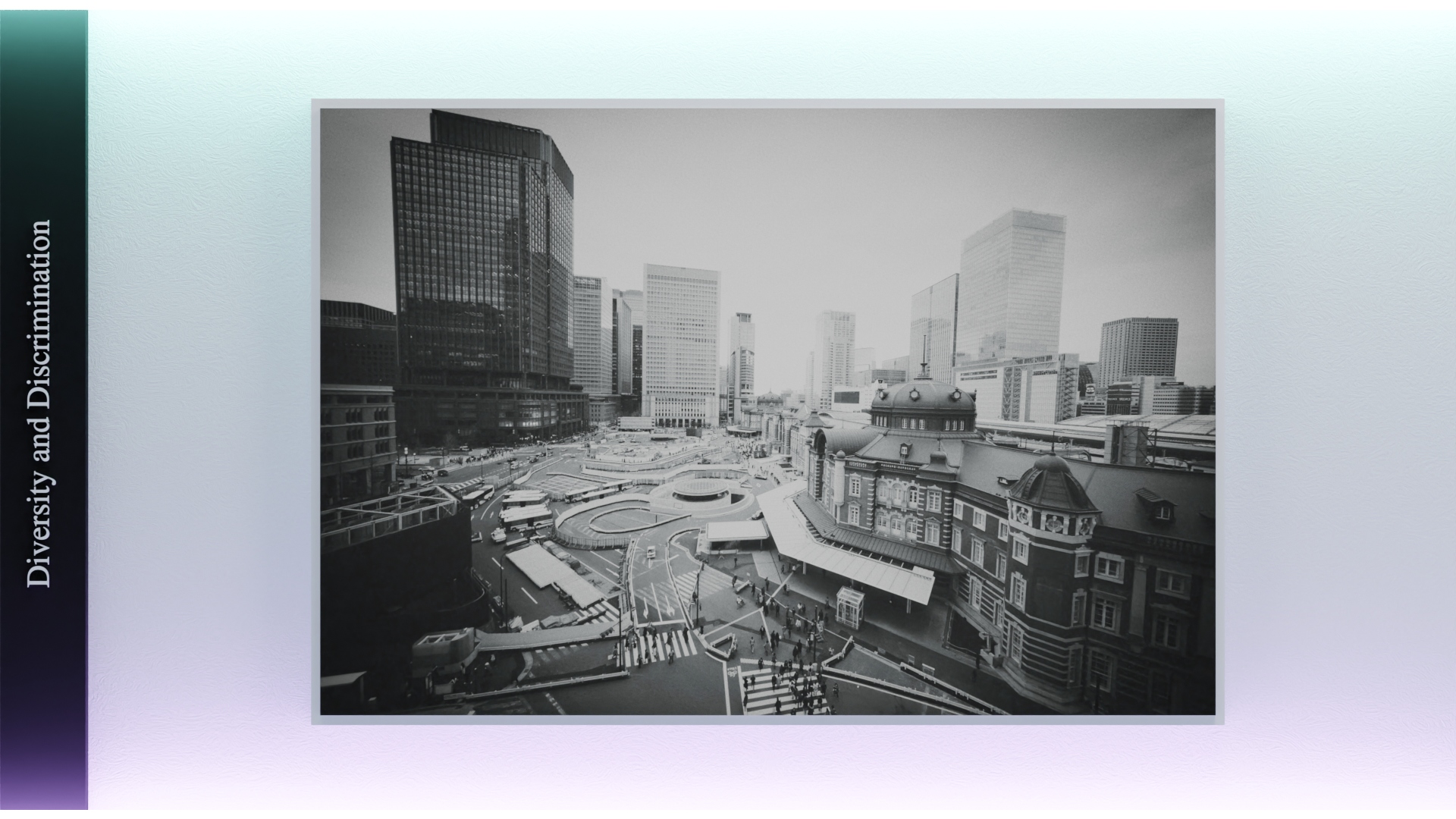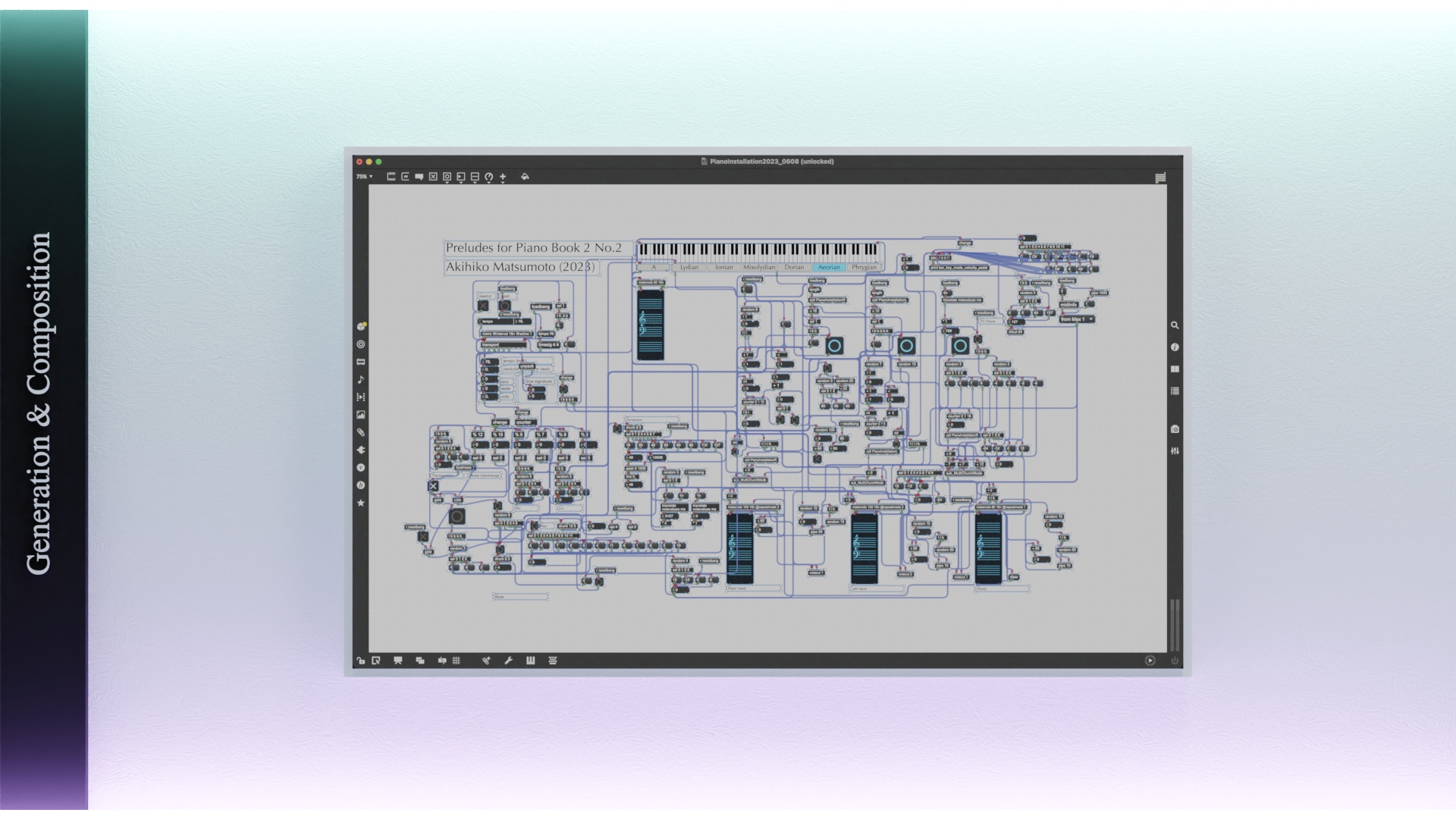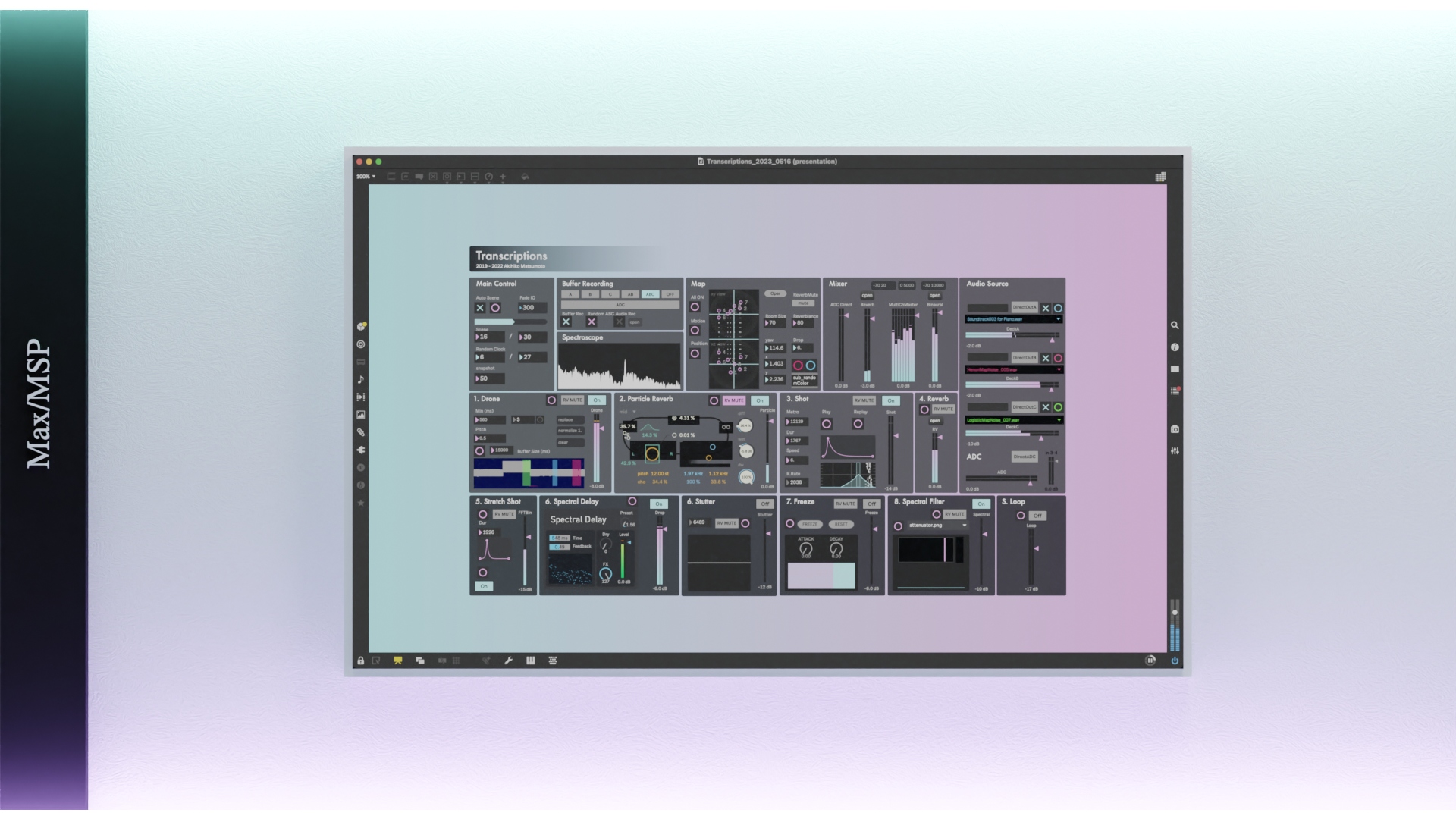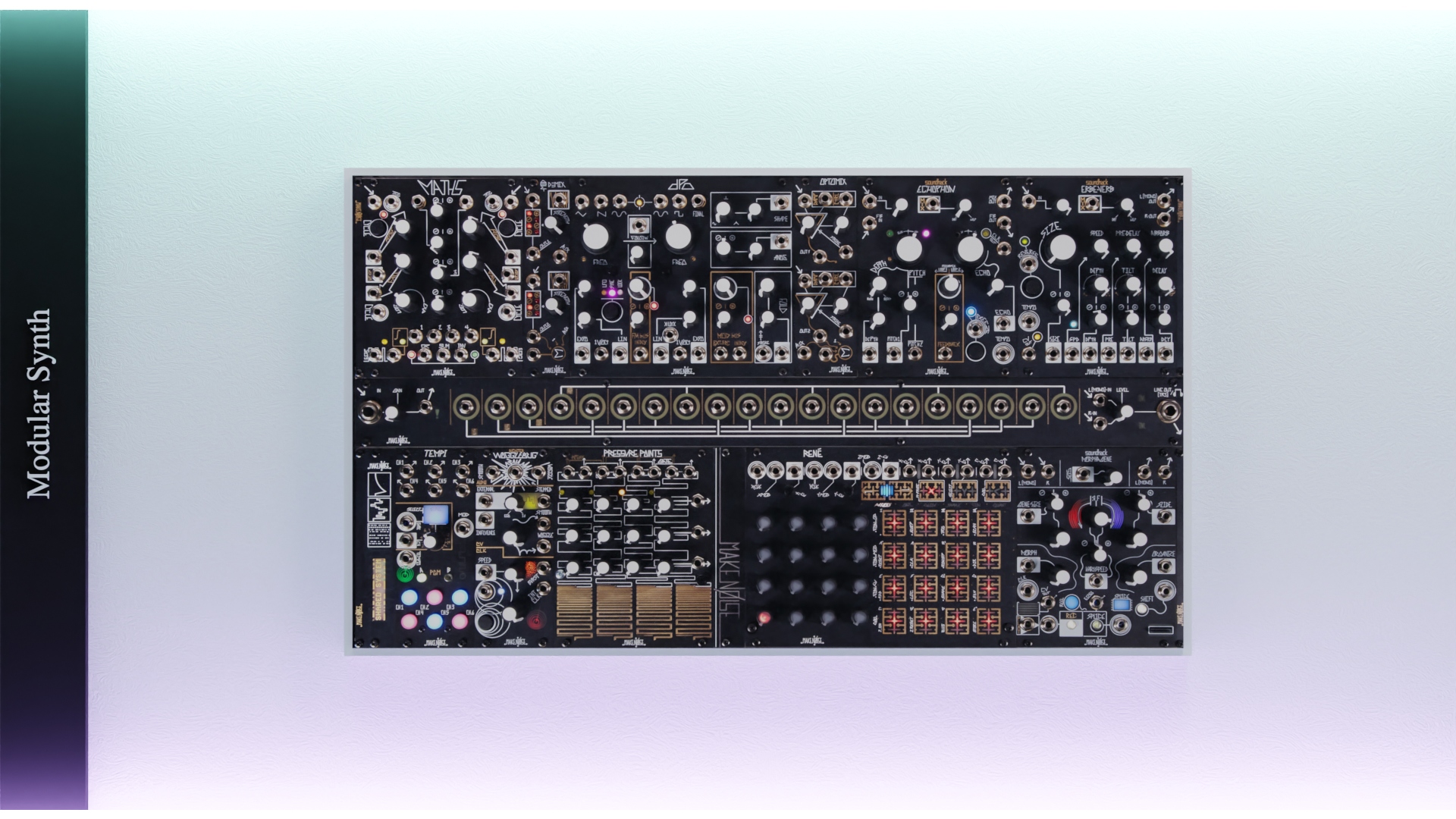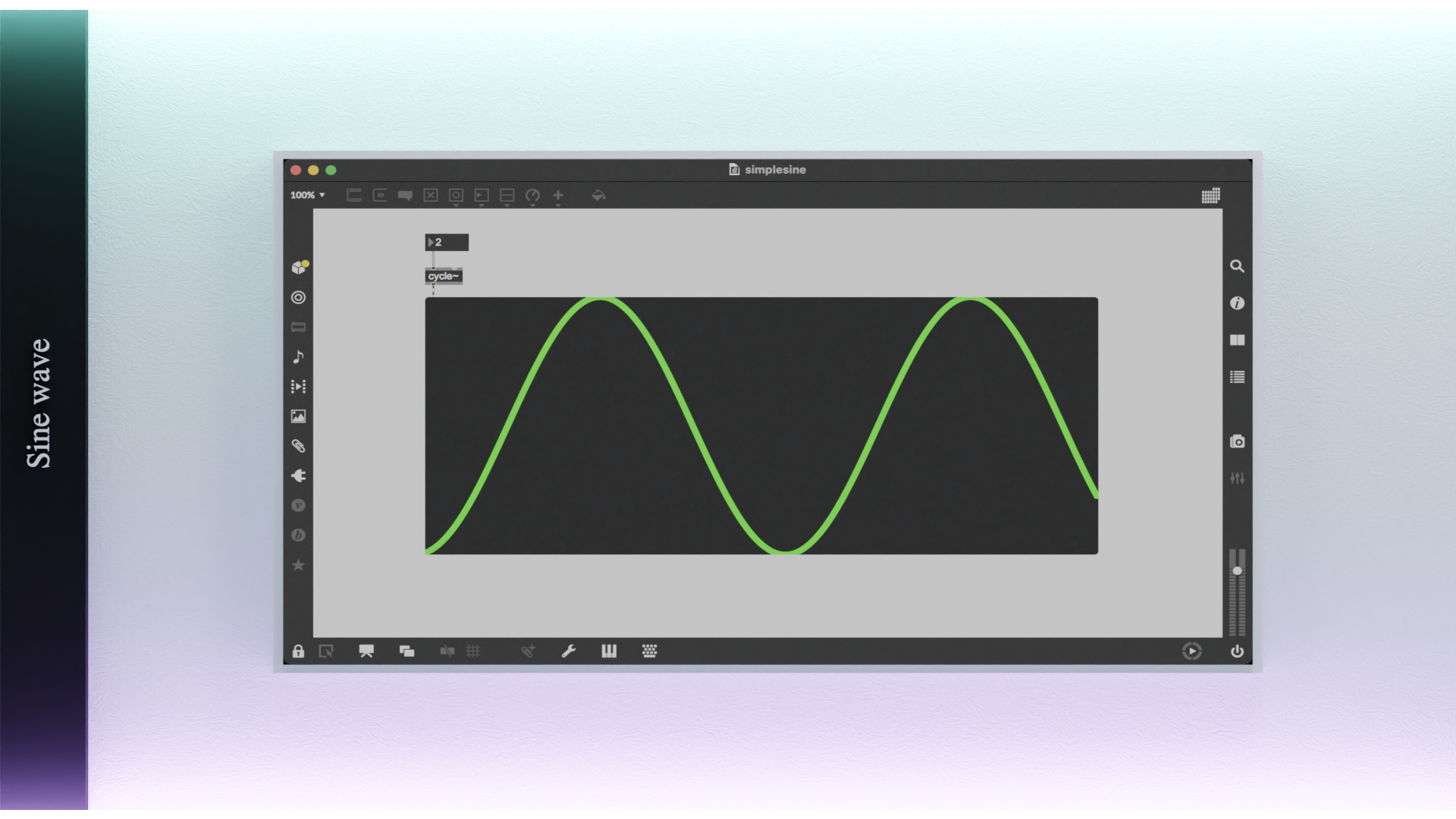
Sine wave
If we break down the components into smaller pieces for better understanding when working with music and sound design, the first and most basic topic to consider is sine wave. We humans perceive the invisible phenomenon of air density changes in nature as sound through our ears. The smallest unit of sound is a sine wave with one period. We may say that composition is the macroscopic way to compose sine wave, and sound design is the microscopic way to compose sine wave.
A sine wave is the only wave among the various waveforms that has a single frequency component, that is, it
is a pure sound that contains no overtones or incidental layers of sound, but in a strict sense, pure sine
waves do not exist in nature.
In other words, sound composed of sine waves has the potential to develop a sound world unique to electronic
music that cannot be realized in the acoustic world.
An especially interesting part of the generation of accurate sine waves with stable pitch and volume, made possible by digital technology, is the phenomenon of interference. Do you remember studying in high school physics class that when sine waves of adjacent frequencies are superimposed on each other, the difference in frequency becomes a beat, and the rhythm of the sound is created? When stable sine waves are used, this rhythm is mechanically accurate, so it is possible to play inhuman rhythms like techno with beats generated spontaneously by the difference in frequencies. Ryoji Ikeda is a representative example of the application of this phenomenon in his works.
音楽やサウンドデザインに取り組む上で理解を深めるために構成要素を細かく分解していくと、まず最も基本的なトピックとしてサイン波が考えられます。 自然界での空気の密度の変化という目では見えない現象が音として耳から知覚されるのが我々人間です。音の最小単位がどこなのか探ると1周期のサイン波になります。そのサイン波をどう構成していくかマクロで捉えたものが作曲であり、ミクロで捉えたものがサウンドデザインだと言えるかもしれません。
サイン波はさまざまな波形の中で唯一、たった一つの周波数成分を持つ波動、つまり倍音や付随するような音の重なりが全く含まれない純粋な音ですが、厳密な意味で純粋なサイン波は自然界には存在しないと言われています。
つまり、サイン波のみで構成する音というのはアコースティックな世界では実現が不可能なエレクトロニックミュージックならではの音世界を展開できる可能性も秘めてます。
特にデジタルテクノロジー以降可能になったピッチや音量の安定した正確なサイン波の生成で面白い部分は干渉という現象です。近接する周波数のサイン波同士を重ね合わせるとその周波数の差分がビートとなって、音のリズムを刻む現象は高校の物理で勉強した記憶はありませんか?安定したサイン波を使うと、このリズムが機械的に正確であるため周波数の差分で自然発生するビートでまるでテクノのような非人間的なリズムを奏でることも可能になります。こういった現象を作品に応用している代表例が池田亮司です。
Overtones
倍音
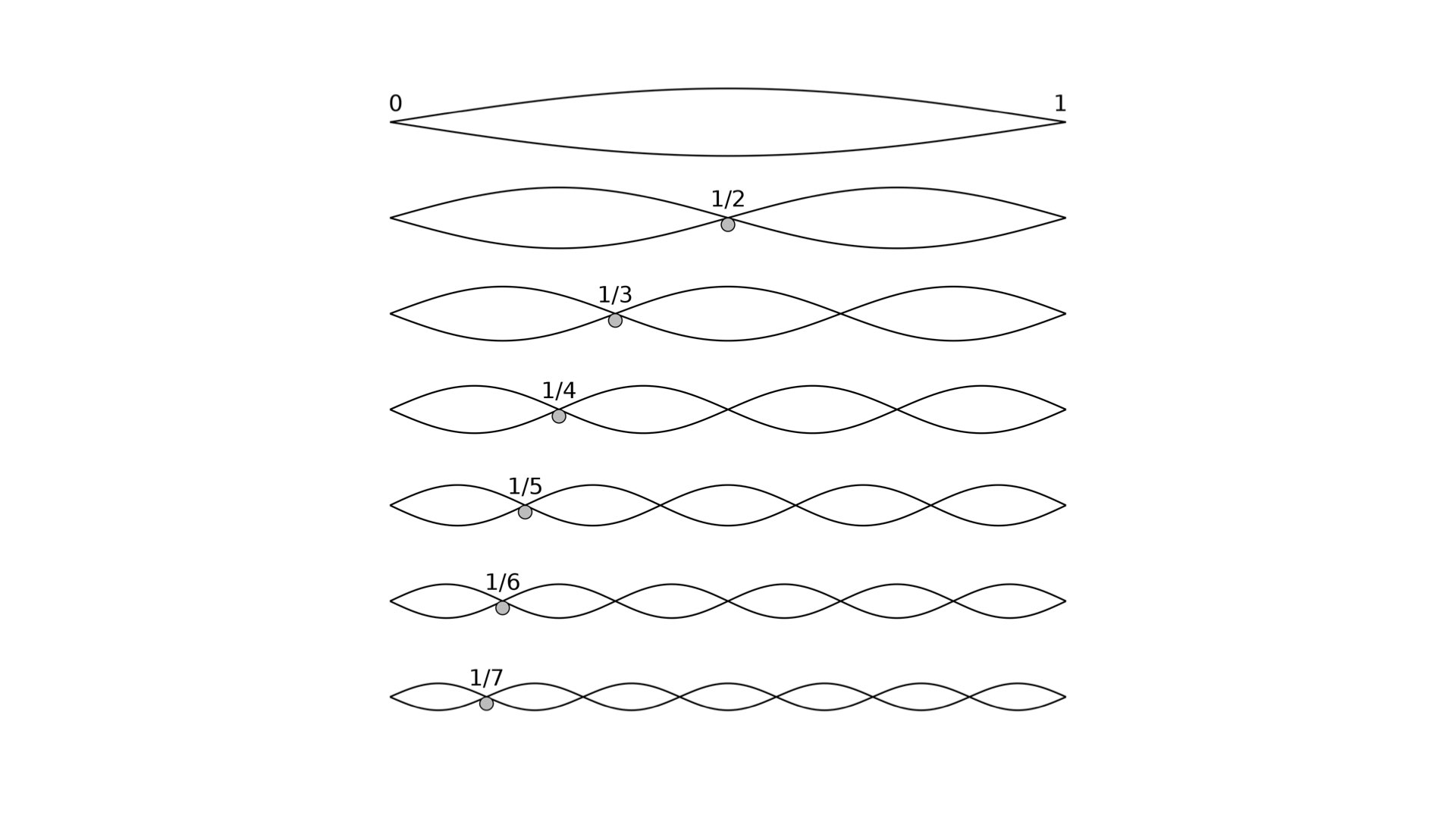
The sound of various musical instruments, such as the sound of a piano, a guitar, or a violin, contains overtones. An overtone is also a state in which multiple sine waves are superimposed. Various unique tones are created when sounds with integer multiples of two or three times the frequency of the fundamental sound are superimposed, and they are all sine waves of different frequencies.
The method of synthesis that creates sound by layering overtones with sine waves is called additive synthesis. Even square waves and sawtooth waves, familiar to those who have used synthesizers, can be reproduced by stacking sine waves. However, a huge number of sine waves are required to reproduce all kinds of tones. Because of the increased computational complexity, electronic instruments and computers until the 20th century rarely implemented and commercialized sine waves, despite the simplicity of the principle.
ピアノの音、ギターの音、ヴァイオリンの音などさまざまな楽器の音には倍音が含まれます。そして倍音は複数のサイン波が重なり合った状態でもあります。基音となる音の周波数に対して、2倍、3倍と整数倍の周波数の音が積み重なってさまざまな個性的な音色が生まれますが、その正体はすべて異なる周波数のサイン波です。
サイン波による倍音を重ねて音を作っていく音響合成の方式は加算合成と呼ばれます。 シンセサイザーを使ったことがある人にはお馴染みの矩形波やノコギリ波すらサイン波を積み重ねることで再現することが可能です。ただし、あらゆる音色を再現しようとすると膨大な数のサイン波が必要になります。このことが計算量を増やすため、20世紀までの電子楽器やコンピューターでは原理こそ単純であれ実装されて製品化されることは稀でした。
Sin - Saw - Tri - Sqr
サイン波 - ノコギリ波 - 三角波 - 矩形波

Cycling '74 Max 8
Download Max Patch basicwavefoorm.maxpat
Now that we have published a program that allows you to listen to sounds using Cycling '74 Max, let's take a look at the relationship between the waveform and the overtone structure most frequently employed in the oscillator portion of synthesizers while actually running the program. If you do not yet have Max, please download it from the download link at the bottom of the page. You cannot edit the program without using the paid version, but you can run the distributed program and make sounds while changing the parameters.
Sine wave does not contain any overtones, as can be seen from the spectrogram, which displays the volume of each frequency The overtones of sawtooth waves include both even and odd harmonics, and the volume of the nth harmonic (a sine wave with a frequency N times that of the lowest reference note) has the characteristic of becoming 1/N, for example, the volume of the 8th harmonic is 1/8. As a tone, it is used to create brass or string-like sounds.
Triangule wave is a waveform that contains only odd harmonics, with the volume of the Nth-order harmonic being 1/N squared. Since the higher the order of overtones, the lower the volume, it is often used to create bass tones in electronic music or soft flute-like tones.
Like triangle wave, square wave contains only odd harmonics, but since the volume of the Nth harmonic is 1/N, it may be thought of as a triangle wave with a louder version of the harmonics. It is used to create sounds like woodwinds, but it can also be filtered to create a dubstep-like wobble bass, detuned to create a neo-grime lead-like tone, or used as a standard chiptune tone since many old video game sounds were made with square waves, It may be the waveform with the greatest range of applications.
Cycling '74 Maxを使って実際に音を聴けるプログラムを公開したので、実際に動かしながらシンセサイザーのオシレーター部分で最も頻繁に採用される波形と倍音構成の関係を見てみましょう。 Maxをまだお持ちでない方はページの最下部にダウンロードリンクを貼っているのでダウンロードしてみてください。プログラムの編集は有料版を使わなければできませんが配布したプログラムを実行してパラメータを変化させながら音を出すことは可能です。
サイン波は一切の倍音を含まないことがスペクトログラムという周波数ごとの音量を表示するものからも見てとれると思います。 ノコギリ波の倍音は偶数倍音と奇数倍音両方を含み、N次倍音(基準となる最低音のN倍の周波数のサイン波)の音量は1/Nとなっていく特性があり、例えば第8倍音の音量は1/8となります。音色としてはブラスやストリングスのような音を作る時に利用されます。
三角波は奇数倍音のみを含む波形で、N次倍音の音量は1/N2乗となります。高い次数の倍音ほど音量は小さくなる特性のため、エレクトロニックミュージックのベースの音色ややわらかいフルートのような音色を作るときなどによく使用されます。
矩形波も三角波同様に奇数倍音のみを含みますが、N次倍音の音量は1/Nとなるため、倍音の音量が大きバージョンの三角波として考えることもできるかもしれません。木管楽器のような音を作る時に利用されますが、フィルターを通してダブステップのようなワブルベースを作ったり、ディチューンさせてネオグライムのリードのような音色を作ったり、古いゲーム機の音は多くが矩形波で作られているためチップチューンの音色の定番になっていたり、応用範囲は最も多い波形かもしれません。
Let's take a look at a prior example of a work that was conceptually created using sine waves.
ここでコンセプチュアルにサイン波を用いて作られた作品の先行事例を見てみましょう。
The Sine Wave Orchestra - stay
(2017)
Commissioned by Yamaguchi Center for Arts and Media [YCAM]
Equipment support FOSTEX COMPANY
Co-developed with YCAM InterLab
https://swo.jp
The SINE WAVE ORCHESTRA (SWO) is a project that works exclusively with sine waves that was launched in 2002 by Ken Furudate, Kazuhiro Jo, Daisuke Ishida and Mizuki Noguchi.
The work "stay" is an installation work in which a device that emits sine waves, the frequency of which can be freely set by the viewer, is placed in any position on wires installed at the venue, creating a more complex space as the exhibition progresses.
SINE WAVE ORCHESTRA(SWO)は、2002年に古舘 健、城 一裕、石田大祐、野口瑞希によって発足した正弦波だけを使ったプロジェクトです。
"stay"という作品は鑑賞者が自由に周波数を設定したサイン波鳴らすデバイスを、会場に設置されたワイヤーの好きな位置に配置することで会期が進むとより複雑な空間が生み出されるインスタレーション作品です。
Ryoji Ikeda - test pattern [100m version]
(2013)
AUG 23-25, SEP 4-15, 2013: Ruhrtriennale, Kraftzentrale, Duisburg, DE
concept, composition: Ryoji Ikeda
computer graphics, programming: Tomonaga Tokuyama
https://www.ryojiikeda.com
Ryoji Ikeda creates site-specific works around the world using digital technology to the utmost limit, making full use of the physical characteristics of sound, its relationship to human perception, time, and space. His works are characterized by his composition of data by reducing light and sound to the smallest unit of pixels, white noise, and sine waves, and structuring them based on a variety of concepts.
池田亮司は音の物理的特性や人間の知覚との関係性、時間、空間を駆使しデジタルテクノロジーを極限まで用いたサイトスペシフィックな作品を世界中で展開しています。光や音を最小単位のピクセルやホワイトノイズやサイン波まで還元し、さまざまなコンセプトに基づき構造化することでデータをコンポジションすることが特徴的です。
Additive Synthesis
加算合成

4th century AD "Mosaic of the Female Musicians" showing a woman playing organ from a Byzantine villa in Maryamin, Syria.
The idea of additive synthesis can be traced back to medieval organs, long before the invention of
synthesizers and electronic technology.
The mechanism of creating various tones by changing the air flowing through the physical pipes with numerous
organ stops and their combination type may be said to be a synthesizer before the advent of electronic
technology.
The interesting thing is that the organ, which can be called the oldest synthesizer in existence since the Middle Ages, is still in use around the world in the 21st century, and works for the organ are still being written and attracting people today. It is simply amazing to see the longevity of the instrument before the advent of electronic technology.
加算合成の考え方はシンセサイザーや電子技術が登場するはるか以前、中世のオルガンにその萌芽が見て取れます。
多数のオルガンストップを備え、その組み合わせ型でさまざまな音色を物理的パイプに流れる空気を変化させながら作っていく仕組みは電子技術が登場する前のシンセサイザーと言えるかもしれません。
そして面白いところは、中世から存在する最古のシンセサイザーとも呼べるオルガンという楽器が21世紀の現代においても世界中で現役で、今もなおオルガンのための作品が書かれ人々を魅了しているところなのではないでしょうか。電子技術が生まれる以前の楽器の寿命にはただただ驚くばかりです。
Synthesizer
シンセサイザー
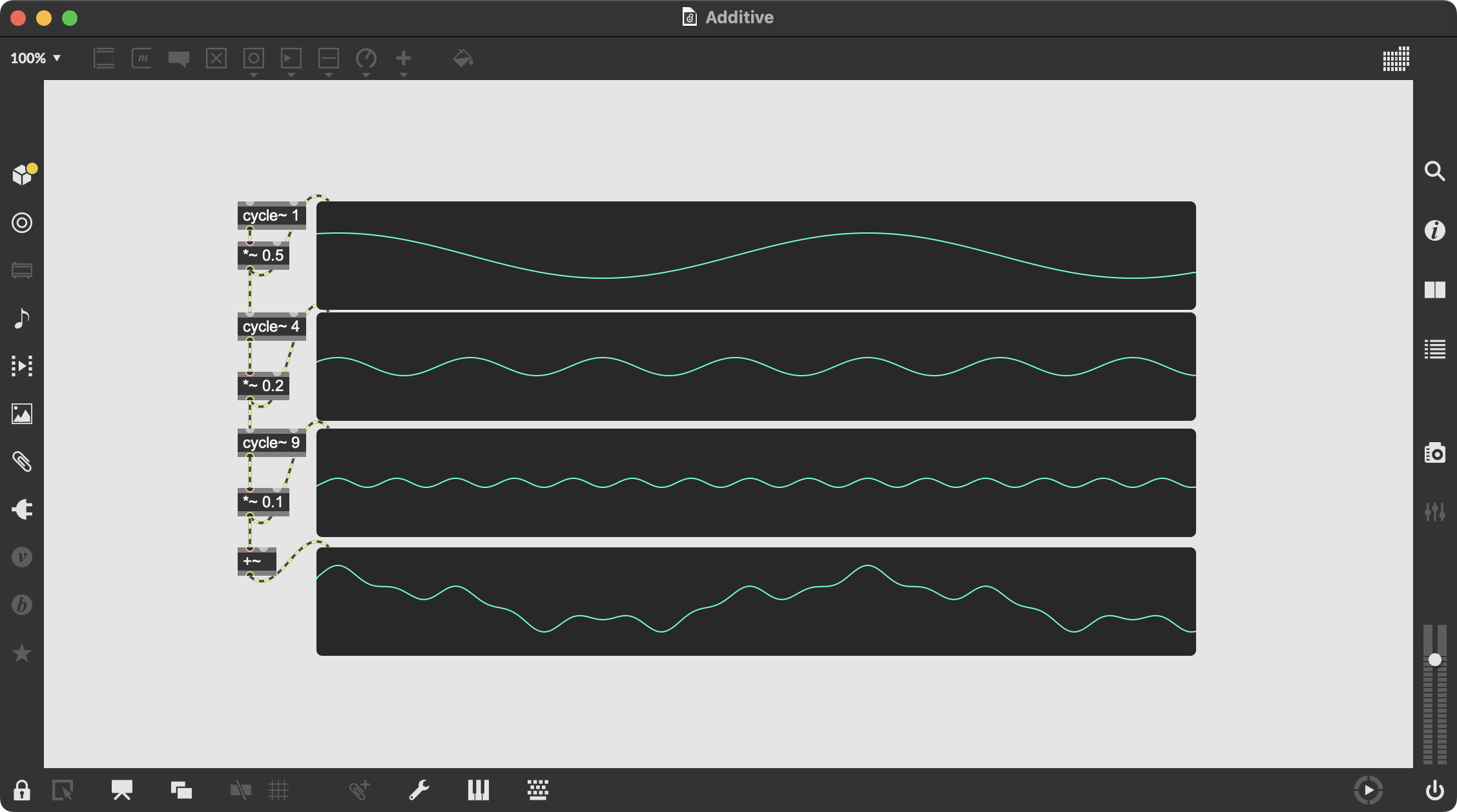
There are not many synthesizers that use additive synthesis of sine waves to create tones, but several
exist, both in software and hardware.
Digital additive synthesis is now capable of producing not only integer overtones with integer frequency
ratios, but also metallic tones with a large number of overtones in complex ratios, as represented by the
Razor and Odessa tones, a characteristic of digital additive synthesis now that machine power has become
more ample.
Native Instruments Razor
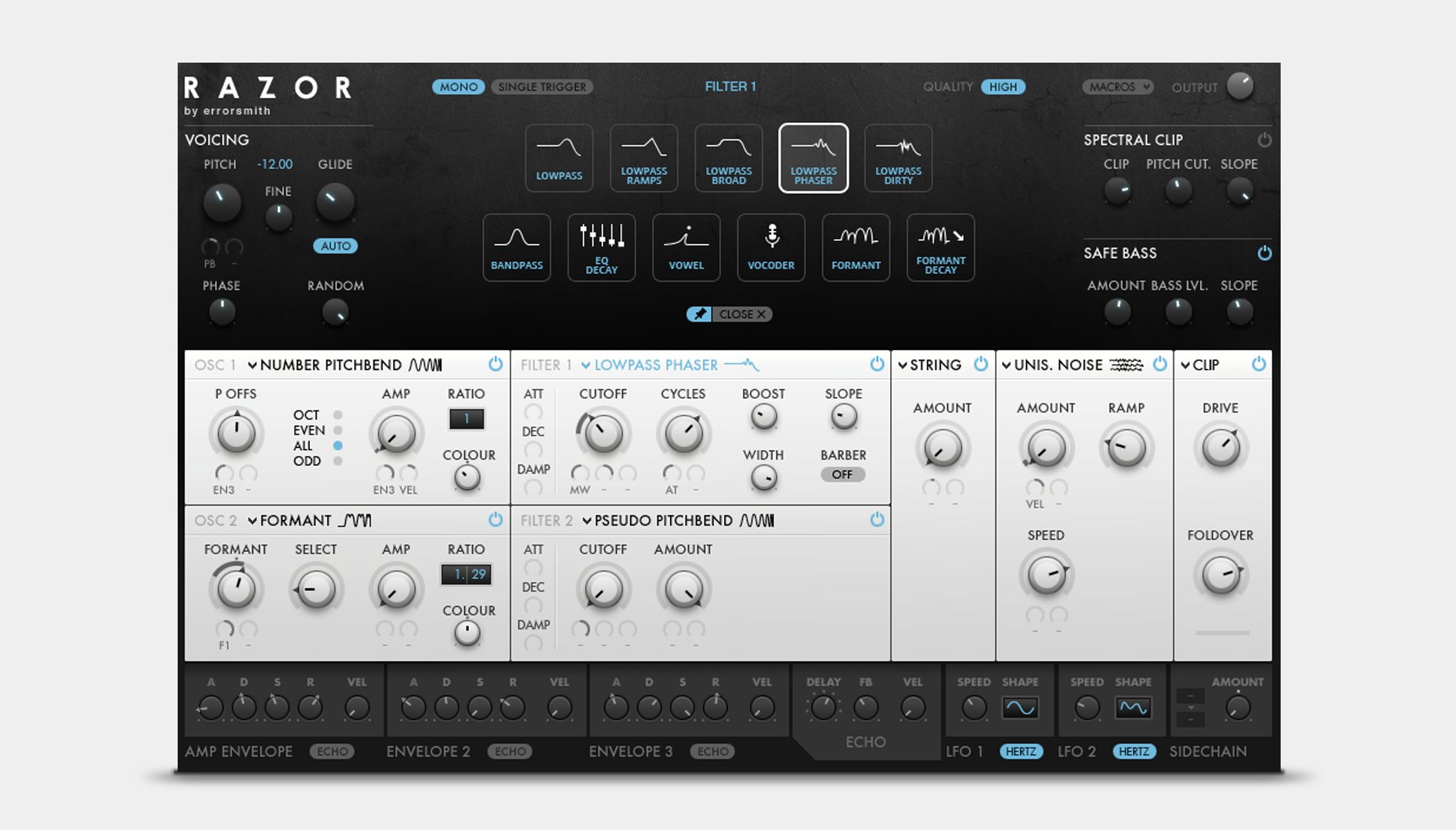
サイン波の倍音加算合成で音色を作るシンセサイザーは多くはありませんが、ソフトウェアでもハードウェアでもいくつか存在します。
整数倍の周波数比となる整数倍音のみならず、RazorやOdessaの音色に代表されるように、複雑な比率で大量の倍音が積み重なる金属的な音色も出せるようになってきているのがマシンパワーに余裕が出てきた昨今のデジタルの加算合成の特徴です。
Xaoc Devices Odessa
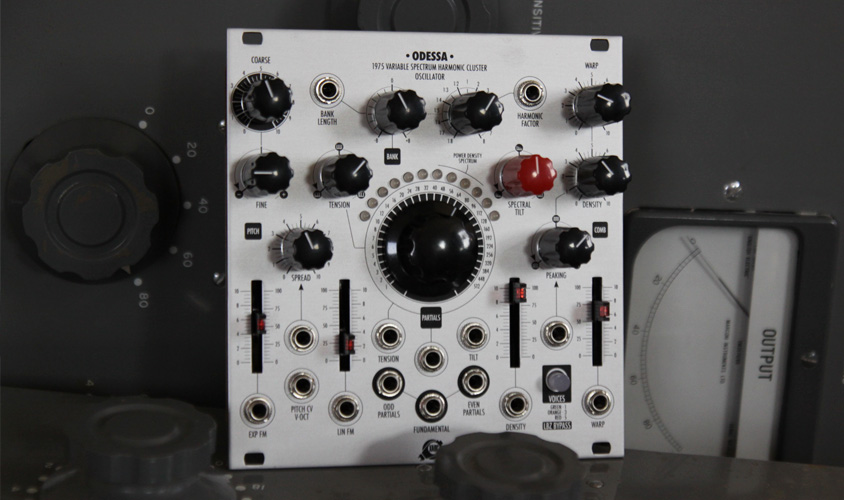
These modern digital additive synthesizers allow more than 1000 overtones to be set, making it possible to create tones with rich overtones, especially in the low frequency range. The 100th overtone of 40 Hz is 4000 Hz, a frequency that can be perceived by the human ear. You can imagine the importance of the number of overtones. On the other hand, analog additive synthesis, such as Verbos' Harmonic Oscillator, which can only be set to 8 overtones, also has a different appeal from digital synthesis.
Verbos Electronics Harmonic Oscillator

こういった最近のデジタルの加算合成シンセサイザーでは倍音は1000個以上設定できるので、特に低域で倍音が豊かな音色を作ることが可能になります。40Hzの第100倍音は4000Hzなので十分に人間の耳で知覚できる周波数です。倍音の数の重要性も想像できるでしょう。 一方でVerbosのHarmonic Oscillatorのように倍音が8までしか設定できないアナログの加算合成もデジタルとは異なる魅力があります。
Kawai K5000 S

Also, a method called resynth, which analyzes the momentary overtone structure of the input sound and reconstructs the sound with a free pitch using a set of sine waves, such as Make Noise Spectraphon, may be considered a kind of additive synthesis.
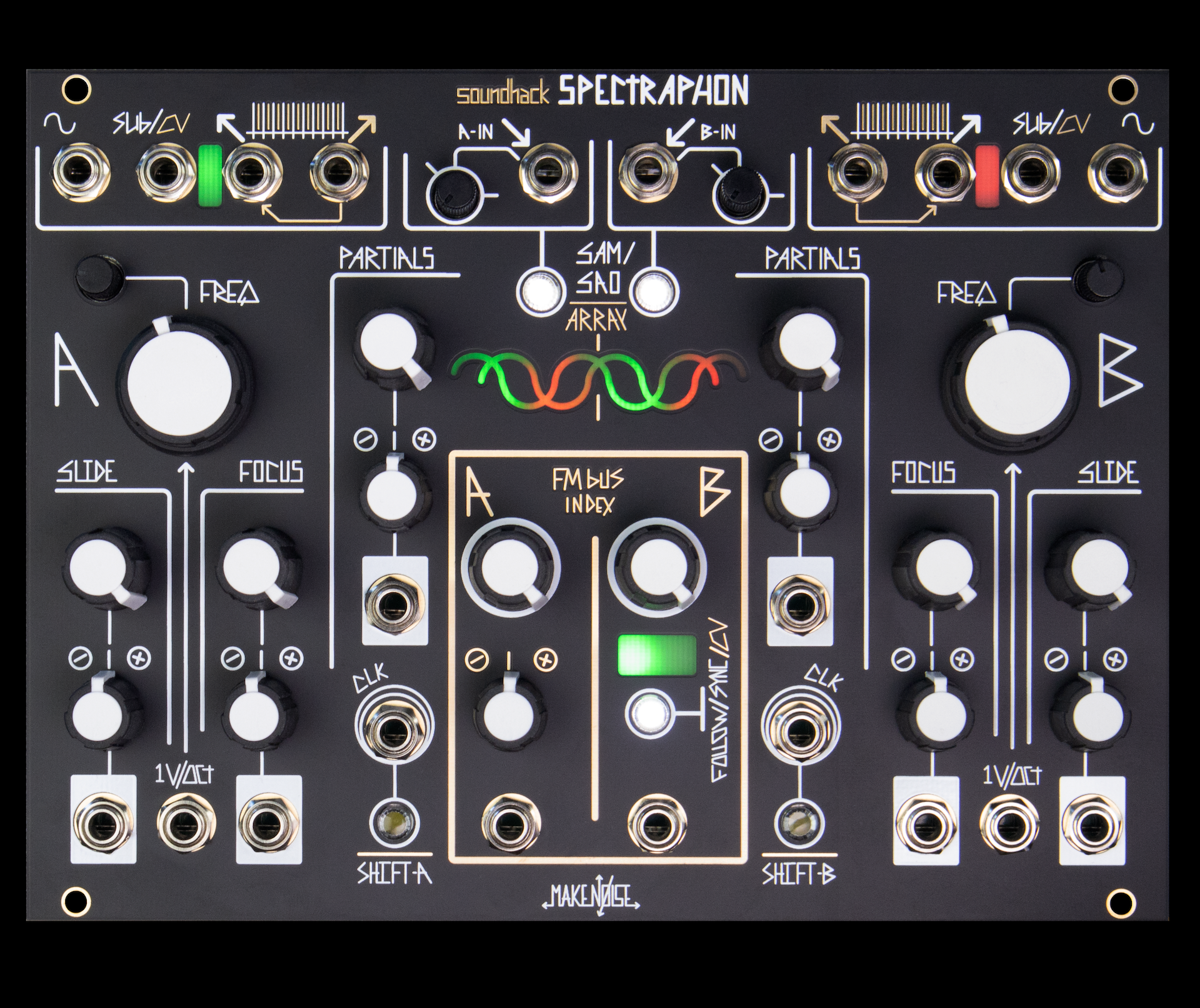
また、Make Noise Spectraphonのように入力される音の一瞬の倍音構造を分析しサイン波の集合で自由なピッチで音を再構築するリシンせと呼ばれる手法も一種の加算合成と考えることができるかもしれません。

Micro vs Macro
ミクロ対マクロ
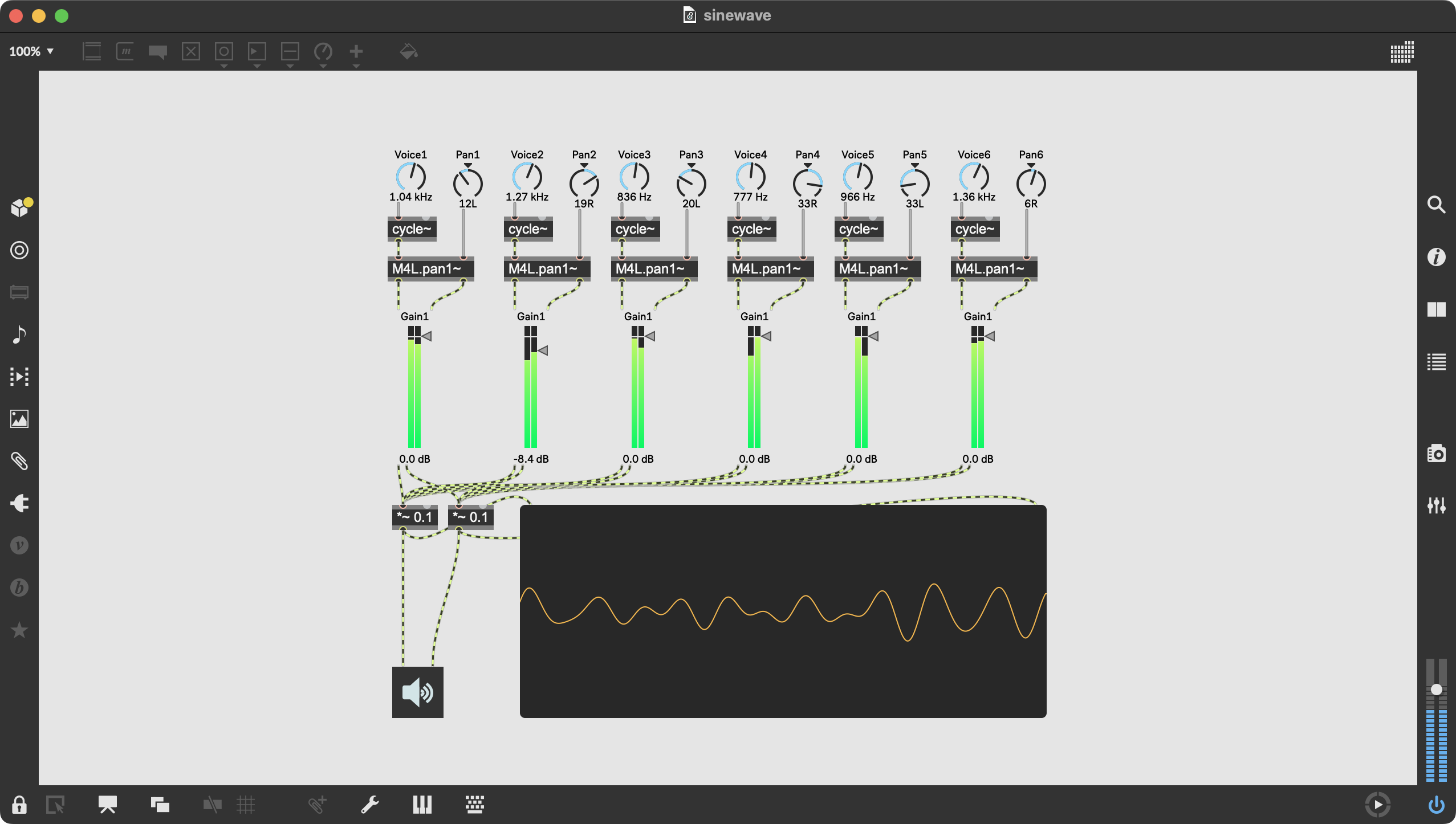
Download Max Patch sinewave.maxpat
Download Ableton M4L device sinewave.amxd
If we review that each and every partial in the overtone structure is a sine wave, it also opens up the possibility of transforming it into various elements of music by freely designing sine wave setting without being bound by the concept of overtones. This kind of thinking is also implemented in the 4ms modular synthesizer Ensemble Oscillator, a 4ms modular synthesizer. It could be polyphonic music with sine waves, it could be chords, it could be overtones, or it could be a detuned tone with many slightly pitch-shifted sine waves placed around a reference frequency.
Here we have a maxpat with six oscillators, left and right panning, and volume control. The structure is simple, but you can experiment with the variety of sounds you can create with this alone. The simplicity of this product will reflect your tastes and preferences. Also, note the similarity between the process of timbre formation through the independent and time-varying overtones of real-world live instruments without stagnation, and the polyphonic chants of the 16th century, which consisted of multiple voices, each of which was composed independently of the other and varied over time. You can imagine the possibility that composition and sound design may actually follow basically the same path, just from a macro or micro perspective of sound phenomena.
倍音構造の中での一つ一つの部分音はサイン波になっているということを振り返ると、倍音という概念にとらわれず、サイン波の設定を自由にデザインすることで、音楽のさまざまな要素に変容する可能性も開けてきます。こういった考え方は4msのモジュラーシンセのEnsemble Oscillatorでも実装されています。 それはサイン波のポリフォニー音楽になるかもしれませんし、和音になるかもしれませんし、倍音として、もしくは基準となる周波数付近に少しピッチをずらしたサイン波を多数配置したディチューンの音色になるかもしれません。
ここに6つのオシレーターと左右のパンニングと音量をコントロールできるmaxpatを用意しました。構造はシンプルですが、これだけでもさまざまな音を作れることを実験してみてください。 単純だからこそ、そこにはきっちりあなたの趣味趣向が反映されるでしょう。 そして、現実世界の生楽器の各倍音が停滞することなく独立して時間的に変化し続けていき、音色が形作られていく過程と、多声部からなる16世紀のポリフォニーの聖歌がそれぞれの声部で独立して時間的に変化し、作曲が行われていたこととの類似性にも着目してみてください。作曲とサウンドデザインが実は音の現象をマクロから見るかミクロから見るかの違いなだけで、基本的には同じような道を辿る可能性を想像できるでしょう。
Demo
デモ
Reference
Curtis Roads. The Computer Music Tutorial. MIT Press https://mitpress.mit.edu/9780262680820/the-computer-music-tutorial/
Charles Dodge. Computer Music: Synthesis, Composition, and Performance. Schirmer Books https://amzn.to/463ehCu
Kim Bjørn. PATCH TWEAK. Bjooks https://bjooks.com/products/patch-tweak-exploring-modular-synthesis
Dennis DeSantis. Making Music Creative Strategies for Electronic Music Producers. Ableton https://makingmusic.ableton.com

